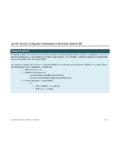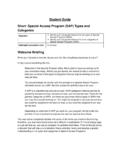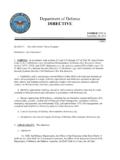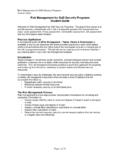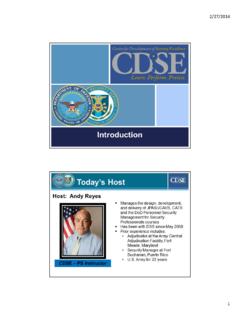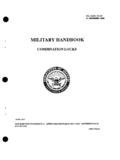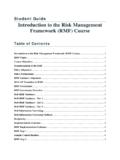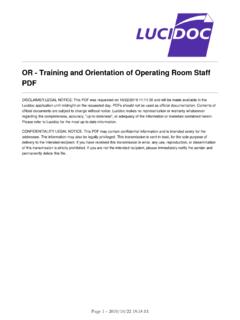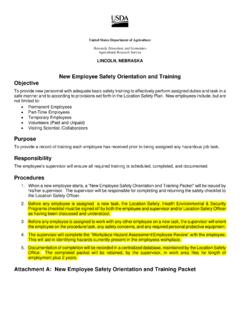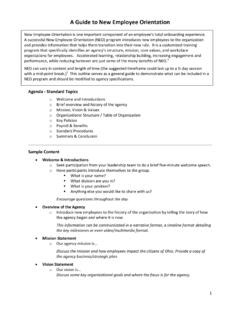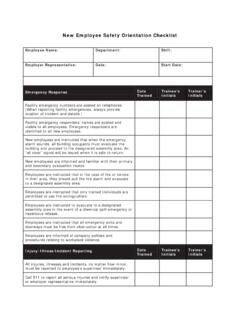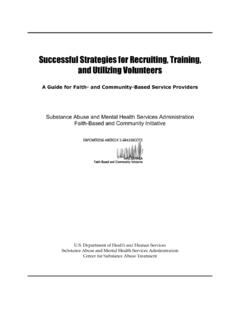Transcription of Student Guide - DOD Initial Orientation and Awareness …
1 DOD Initial Orientation and Awareness training Student Guide 8/12/2021 1 of 24 Student Guide - DOD Initial Orientation and Awareness training Introduction Welcome to the Department of Defense, or DOD Initial Orientation and Awareness training ! The purpose of this training is to provide you with the basic security knowledge necessary to recognize threats to our National Security information and be able to counter those threats in the performance of your responsibilities. Security Managers, if you need to customize this training to meet your organization s needs, a customizable template is available in the resources tab. Objectives By the end of this course, you will be able to: Describe the National Security eligibility Process Understand the Information Security Program and your role in it Describe the pre-publication process Explain the importance of the Physical Security Program in protecting classified national security information Recognize the role of Operations Security (OPSEC) Understand the requirements for reporting foreign travel Introduction to Personnel Security The Personnel Security Program (PSP) aims to protect national security by ensuring only loyal, trustworthy, and reliable individuals may access classified information and/or be assigned to national security sensitive positions.
2 It also establishes the standards, criteria, and guidelines upon which personnel security determinations are based. Finally, it uses a comprehensive background investigative process to make this determination. Two key aspects of the PSP are providing access to classified information and ensuring the protection of national security. Position Designations Whenever a DOD employee or contractor requires access to classified national security information in the performance of their duties, the individual must be granted national security eligibility at the proper level to access that information. National security eligibility is a favorable determination that affords an individual eligibility for access to classified information or assignment to a national security sensitive position.
3 The National Security Eligibility Process is a four-phased approach that ensures the DOD does not grant access to national security information to people who cannot be trusted. DOD Initial Orientation and Awareness training Student Guide 8/12/2021 2 of 24 Civilian personnel designation requirements vary based on how the position is categorized. Within the DOD, each position is categorized with respect to security sensitivity. The Office of Personnel Management (OPM) defines the four civilian position sensitivity levels as Special Sensitive, Critical Sensitive, Non-Critical Sensitive, and Non-Sensitive. Special Sensitive: Position requires eligibility for access to Sensitive Compartmented Information (SCI)/Top Secret (TS) or Special Access Program (SAP) level information and has the potential for inestimable damage to National Security.
4 (Tier 5) Critical Sensitive: Position requires eligibility for access to Top Secret (TS) information and has the potential for exceptionally grave damage to National Security. (Tier 5) Non Critical Sensitive: Position requires eligibility for access to Secret or Confidential level information and has the potential for significant or serious damage to National Security. (Tier 3) Non-Sensitive: Position requires no eligibility and does not pose damage to National Security. (Tier 1) National Security Eligibility Process Military, civilian, contractor, consultant, and other affiliated personnel assigned to national security positions or who are required to perform national security duties will be subject to investigation to determine whether they are and will remain reliable, trustworthy, of good conduct and character, and loyal to the United States and whether granting or continuing national security eligibility is clearly consistent with the national interest.
5 The four phases of the National Security Eligibility Process are Access, Investigation, Adjudication, and Continuous Evaluation/Periodic Reinvestigation. Access The employing activity determines access level based on eligibility, need-to-know, and the requirements of the position held. Before granting access to classified information, all individuals will execute the appropriate non-disclosure forms in accordance with Section 552 of Title 5, United States Code ( ). If individuals decline to execute the nondisclosure forms, the DOD Component will withhold classified access and report the refusal to the adjudication facility. DOD Components will maintain records of all Initial briefings. Federal Investigative Standards (FIS) The Federal Investigative Standards, also known as FIS, define a five-tiered investigative model developed in accordance with Executive Order DOD Initial Orientation and Awareness training Student Guide 8/12/2021 3 of 24 (EO) 13467, Reforming Processes Related to Suitability for Government Employment, Fitness for Contractor Employees, and Eligibility for Access to Classified National Security Information.
6 The FIS set standard requirements used to conduct background investigations that determine eligibility to access classified information or hold a national security sensitive position. For the purposes of this course, we will only focus on Tier 3 and Tier 5 Access, Investigation, Adjudication, and Continuous Evaluation/Periodic Reinvestigation. National Security Background Investigations The Tier 3 and Tier 5 national security background investigations determine eligibility for: Access to classified information Acceptance or retention in the Armed Forces, and Assignment to a designated national security sensitive position Your refusal to complete security documentation may result in the denial or revocation of your eligibility.
7 Adjudications After the investigation is complete the case is sent to Adjudications to assess the probability of future behavior that could have an adverse effect on national security. The DOD Consolidated Adjudications Facility (CAF) is the primary authority for making security eligibility determinations for DOD personnel. Each case is weighed on its own merits utilizing the whole person concept, which looks at all available and reliable information about an individual s past and present prior to reaching an adjudicative determination. You can find more information on Adjudicative Guidelines in the resource tab. Periodic Reinvestigation/Continuous Evaluation In accordance with DODI , DOD Personnel Security Program (PSP) , all personnel in national security positions shall be subject to continuous evaluation.
8 EO 13467 defines continuous evaluation as DOD Initial Orientation and Awareness training Student Guide 8/12/2021 4 of 24 reviewing the background of an individual who has been determined to be eligible for access to classified information. This includes additional or new checks of commercial databases, Government databases, and other information lawfully available to security officials at any time during the period of eligibility to determine whether that individual continues to meet the requirements for eligibility for access to classified information. Every six years, or as needed, you will be subject to a periodic reinvestigation for continued security eligibility. According to the FIS, there are two types of periodic reinvestigations for national security eligibility: Tier 3 R: Required for continued Secret and Confidential eligibility.
9 Tier 3 R periodic reinvestigations will continue to be conducted every ten years. Tier 5 R: Required for continued TS or SCI eligibility. Tier 5 reinvestigations have been extended from five years to six years with Director of National Intelligence (DNI) endorsement. For more information see the Jan 17, 2017, DOD Memorandum Extension of Periodic Reinvestigation Timelines to Address the Background Investigation Backlog available in the resources. Self-Reporting As part of the National Security Eligibility Process, you must self-report any changes in status, adverse information, and foreign contacts as they occur to the Security Office. Remember, if you don t self-report, someone else might! Reporting does not automatically result in revocation of eligibility so don t be afraid to report!
10 Change in Status Some examples of change in status are: Marriage/co-habitation Addition of a new family member Divorce Receipt of a large sum of cash, for example, lottery winnings. Adverse Information Adverse information may also be reported, but what is adverse information? Adverse information is any information that DOD Initial Orientation and Awareness training Student Guide 8/12/2021 5 of 24 adversely reflects on the integrity or character of a cleared employee, which suggests that his or her ability to safeguard classified information may be impaired or that his or her access to classified information clearly may not be in the interest of national security. Some examples of adverse information that you must self-report include: Criminal activity, including domestic violence or issuance of a restraining order Driving under the influence or driving while intoxicated (known as a DUI or DWI) Traffic tickets in excess of $300 Excessive indebtedness or recurring financial difficulties or bankruptcy Use of illegal drugs or misuse of controlled substances Any pattern of security violations or disregard for security regulations Foreign Contacts DOD personnel are also required to report any close and continuing association with a foreign national to the Security Office.

